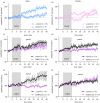Sex-specific and social experience-dependent oxytocin-endocannabinoid interactions in the nucleus accumbens: implications for social behaviour
- PMID: 35858094
- PMCID: PMC9272148
- DOI: 10.1098/rstb.2021.0057
Sex-specific and social experience-dependent oxytocin-endocannabinoid interactions in the nucleus accumbens: implications for social behaviour
Abstract
Oxytocin modulates social behaviour across diverse vertebrate taxa, but the precise nature of its effects varies across species, individuals and lifetimes. Contributing to this variation is the fact that oxytocin's physiological effects are mediated through interaction with diverse neuromodulatory systems and can depend on the specifics of the local circuits it acts on. Furthermore, those effects can be influenced by both genetics and experience. Here we discuss this complexity through the lens of a specific neuromodulatory system, endocannabinoids, interacting with oxytocin in the nucleus accumbens to modulate prosocial behaviours in prairie voles. We provide a survey of current knowledge of oxytocin-endocannabinoid interactions in relation to social behaviour. We review in detail recent research in monogamous female prairie voles demonstrating that social experience, such as mating and pair bonding, can change how oxytocin modulates nucleus accumbens glutamatergic signalling through the recruitment of endocannabinoids to modulate prosocial behaviour toward the partner. We then discuss potential sex differences in experience-dependent modulation of the nucleus accumbens by oxytocin in voles based on new data in males. Finally, we propose that future oxytocin-based precision medicine therapies should consider how prior social experience interacts with sex and genetics to influence oxytocin actions. This article is part of the theme issue 'Interplays between oxytocin and other neuromodulators in shaping complex social behaviours'.
Keywords: CB1 receptor; GABA; pair bonding; sex differences; social behaviour; social reward.
Figures



References
Publication types
MeSH terms
Substances
Grants and funding
LinkOut - more resources
Full Text Sources
